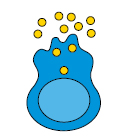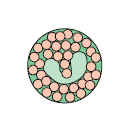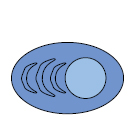Glossary
adenoids—see tonsils.
adrenal gland—a gland located on each kidney that secretes hormones regulating metabolism, sexual function, water balance, and stress.
allergen—any substance that causes an allergy.
 |
| Antibody. Credit: NIAID. |
antibody—a molecule (also called an immunoglobulin) produced by a mature B cell (plasma cell) in response to an antigen. When an antibody attaches to an antigen, it helps the body destroy or inactivate the antigen.
antigen—a substance or molecule that is recognized by the immune system. The antigen can be from foreign material such as bacteria or viruses.
antiserum—a serum rich in antibodies against a particular microbe.
appendix—lymphoid organ in the intestine.
artery—a blood vessel that carries blood from the heart to other parts of the body.
autoantibody—an antibody that reacts against a person’s own tissue.
autoimmune disease—disease that results when the immune system mistakenly attacks the body’s own tissues. Examples include multiple sclerosis, type 1 diabetes, rheumatoid arthritis, and systemic lupus erythematosus.
B cell or B lymphocyte—a small white blood cell crucial to the immune defenses. B cells come from bone marrow and develop into blood cells called plasma cells, which are the source of antibodies.
bacteria—microscopic organisms composed of a single cell. Some cause disease.
basophil—a white blood cell that contributes to inflammatory reactions. Along with mast cells, basophils are responsible for the symptoms of allergy.
blood vessel—an artery, vein, or capillary that carries blood to and from the heart and body tissues.
cell—the smallest unit of life; the basic living unit that makes up tissues.
chemokine—a small protein molecule that activates immune cells, stimulates their migration, and helps direct immune cell traffic throughout the body.
clonal anergy—the process of switching off the ability of potentially harmful T or B cells to participate in immune responses. Clonal anergy is essential for generating the tolerance of T and B cells to the body’s “self” tissue antigens.
clonal deletion—the genetically controlled process of eliminating immune cells that could destroy the body’s own cells and tissues. The elimination process removes immature T and B lymphocytes that have receptors for cells with “self” MHC or HLA antigens, and could therefore attack and destroy the body’s own cells.
clone—a group of genetically identical cells or organisms descended from a single common ancestor; or, to reproduce identical copies.
complement—a complex series of blood proteins whose action “complements” the work of antibodies. Complement destroys bacteria, produces inflammation, and regulates immune reactions.
complement cascade—a precise sequence of events, usually triggered by antigen-antibody complexes, in which each component of the complement system is activated in turn.
cytokines—powerful chemical substances secreted by cells that enable the body’s cells to communicate with one another. Cytokines include lymphokines produced by lymphocytes and monokines produced by monocytes and macrophages.
 |
| Cytotoxic T lymphocyte (CTL). Credit: NIAID. |
cytotoxic T lymphocyte (CTL)—a subtype of T cells that carries the CD8 marker and can destroy body cells infected by viruses or transformed by cancer.
dendritic cell—an immune cell with highly branched extensions that occurs in lymphoid tissues, engulfs microbes, and stimulates T cells by displaying the foreign antigens of the microbes on their surfaces.
DNA (deoxyribonucleic acid)—a long molecule found in the cell nucleus. Molecules of DNA carry the cell’s genetic information.
enzyme—a protein produced by living cells that promotes the chemical processes of life without itself being altered.
 |
| Eosinophil. Credit: NIAID. |
eosinophil—a white blood cell containing granules filled with chemicals damaging to parasites and enzymes that affect inflammatory reactions.
epithelial cells—cells that make up the epithelium, the covering for internal and external body surfaces.
fungus—a member of a class of relatively primitive vegetable organisms. Fungi include mushrooms, yeasts, rusts, molds, and smuts.
gene—a unit of genetic material (DNA) inherited from a parent that controls specific characteristics. Genes carry coded directions a cell uses to make specific proteins that perform specific functions.
genome—a full set of genes in a person or any other living thing.
graft rejection—an immune response against transplanted tissue.
graft-versus-host disease—a life-threatening reaction in which transplanted cells attack the tissues of the recipient.
granule—a membrane-bound organelle (specialized part) within cells where proteins are stored before secretion.
granulocyte—a phagocytic white blood cell filled with granules. Neutrophils, eosinophils, basophils, and mast cells are examples of granulocytes.
growth factors—chemicals secreted by cells that stimulate proliferation of or changes in the physical properties of other cells.
helper T cells (Th cells)—a subset of T cells that carry the CD4 surface marker and are essential for turning on antibody production, activating cytotoxic T cells, and initiating many other immune functions.
hepatitis—the name of several viruses that cause liver diseases. These viruses include hepatitis A, hepatitis B, and hepatitis C.
histocompatibility testing—a test conducted before transplant operations to find a donor whose MHC molecules are similar to the recipient’s; helps reduce the strength of transplant rejection.
 |
| HIV (human immunodeficiency virus). Credit: NIAID. |
HIV (human immunodeficiency virus)—the virus that causes AIDS.
human leukocyte antigen (HLA)—a protein on the surfaces of human cells that identifies the cells as “self” and, like MHC antigens, performs essential roles in immune responses. HLAs are used in laboratory tests to determine whether one person’s tissues are compatible with another person’s, and could be used in a transplant. HLAs are the human equivalent of MHC antigens; they are coded for by MHC genes.
immune response—reaction of the immune system to foreign substances. Although normal immune responses are designed to protect the body from pathogens, immune dysregulation can damage normal cells and tissues, as in the case of autoimmune diseases.
immunoglobulin—one of a family of large protein molecules, also known as antibodies, produced by mature B cells (plasma cells).
immunosuppressive—capable of reducing immune responses.
inflammation—an immune system reaction to “foreign” invaders such as microbes or allergens. Signs include redness, swelling, pain, or heat.
inflammatory response—redness, warmth, and swelling produced in response to infection; the result of increased blood flow and an influx of immune cells and their secretions.
innate—an immune system function that is inborn and provides an all-purpose defense against invasion by microbes.
interferon—a protein produced by cells that stimulates antivirus immune responses or alters the physical properties of immune cells.
interleukins—a major group of lymphokines and monokines.
lymph—a transparent, slightly yellow fluid that carries lymphocytes, bathes the body tissues, and drains into the lymphatic vessels.
lymph node—a small bean-shaped organ of the immune system, distributed widely throughout the body and linked by lymphatic vessels. Lymph nodes are garrisons of B and T cells, dendritic cells, macrophages, and other kinds of immune cells.
lymphatic vessels—a bodywide network of channels, similar to the blood vessels, which transports lymph to the immune organs and into the bloodstream.
lymphocyte—a small white blood cell produced in the lymphoid organs and essential to immune defenses. B cells, T cells, and NK T cells are lymphocytes.
lymphoid organ—an organ of the immune system where lymphocytes develop and congregate. These organs include the bone marrow, thymus, lymph nodes, spleen, and various other clusters of lymphoid tissue. Blood vessels and lymphatic vessels are also lymphoid organs.
lymphokines—powerful chemical substances secreted by lymphocytes. These molecules help direct and regulate the immune responses.
 |
| Macrophage. Credit: NIAID. |
macrophage—a large and versatile immune cell that devours invading pathogens and other intruders. Macrophages stimulate other immune cells by presenting them with small pieces of the invaders.
major histocompatibility complex (MHC)—a group of genes that controls several aspects of the immune response. MHC genes code for “self” markers on all body cells.
mast cell—a granulocyte found in tissue. The contents of mast cells, along with those of basophils, are responsible for the symptoms of allergy.
memory cells—a subset of T cells and B cells that have been exposed to antigens and can then respond more readily when the immune system encounters those same antigens again.
microbe or microorganism—a microscopic living organism. Examples include bacteria, protozoa, and some fungi and parasites. Viruses are also called microbes.
molecule—the smallest amount of a specific chemical substance. Large molecules such as proteins, fats, carbohydrates, and nucleic acids are the building blocks of a cell, and a gene determines how each molecule is produced.
monoclonal antibody—an antibody produced by a single B cell or its identical progeny that is specific for a given antigen. Monoclonal antibodies are used as research tools for binding to specific protein molecules and are invaluable in research, medicine, and industry.
monocyte—a large phagocytic white blood cell which, when entering tissue, develops into a macrophage.
monokines—powerful chemical substances secreted by monocytes and macrophages. These molecules help direct and regulate the immune responses.
 |
| Natural killer (NK) cell. Credit: NIAID. |
natural killer (NK) cell—a large granule-containing lymphocyte that recognizes and kills cells lacking self antigens. These cells’ target recognition molecules are different from T cells.
NK T cell—a T cell that has some characteristics of NK cells. It produces large amounts of cytokines when stimulated, and is activated by fatty substances (lipids) bound to non-MHC molecules called CD1d.
neutrophil—a white blood cell that is an abundant and important phagocyte.
organ—a part of the body that has a specific function, such as the lungs.
organism—an individual living thing composed of one or more cells.
parasite—a plant or animal that lives, grows, and feeds on or within another living organism.
passive immunity—immunity resulting from the transfer of antibodies or antiserum produced by another person.
pathogen—a disease-causing organism or virus.
phagocyte—a large white blood cell that contributes to immune defenses by ingesting microbes or other cells and foreign particles.
phagocytosis—process by which one cell engulfs another cell or large particle.
 |
| Plasma cell. Credit: NIAID. |
plasma cell—a large antibody-producing cell that develops from B cells.
platelet—a cellular fragment critical for blood clotting and sealing off wounds.
serum—the clear liquid that separates from the blood when it is allowed to clot. This fluid contains the antibodies that were present in the whole blood.
spleen—a lymphoid organ in the abdominal cavity that is an important center for immune system activities.
stem cell—an immature cell from which other cells derive. Bone marrow is rich in the kind of stem cells that become specialized blood cells.
T cell or T lymphocyte—a small white blood cell that recognizes antigen fragments bound to cell surfaces by specialized antibody-like receptors. “T” stands for the thymus gland, where T cells develop and acquire their receptors.
T cell receptor—complex protein molecule on the surfaces of T cells that recognizes bits of foreign antigen bound to self-MHC molecules.
tissue—a group of similar cells joined to perform the same function.
tissue typing—see histocompatibility testing.
tolerance—a state of immune nonresponsiveness to a particular antigen or group of antigens.
Toll-like receptor (TLR)—a family of proteins important for first-line immune defenses against microbes.
tonsils and adenoids—prominent oval masses of lymphoid tissues on either side of the throat.
toxin—an agent produced in plants and bacteria, normally very damaging to cells.
vaccine—a preparation that stimulates an immune response that can prevent an infection or create resistance to an infection. Vaccines do not cause disease.
vein—a blood vessel that carries blood to the heart from the body tissues.
virus—a particle composed of a piece of genetic material—RNA or DNA—surrounded by a protein coat. Viruses can reproduce only in living cells.
back to top